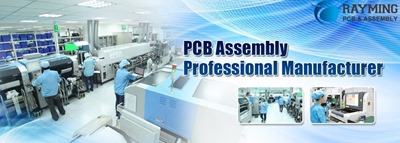The printed circuit is made of epoxy resin or fiberglass , lined with a thin layer of copper on one or both sides and covered with a photo-sensitive varnish.
The lacquer layer protects the copper is irradiated, by imagewise transfer of the copper pattern through an artwork with a platesetter . The varnish that has been exposed to UV is removed with a developer composed of a solution of oxalic of sodium hydroxide . The exposed copper zones are then chemically etched, thus allowing the manufacture of electrical circuits on demand. RayMing PCB Manufacturer is one of the the leading manufacturer in the market.
The chemical etching of the copper can be carried out with liquid and hot iron chloride , or a mixture of copper chloride , hydrochloric acid and hydrogen peroxide (which has the advantage of recycling the reacted copper, then in the form of copper chloride, as reagent for subsequent etching).
The copper remaining on the epoxy support is then freed of its photosensitive protective lacquer and tinned either with a solution of cold tin in a bath or hot in a tin mill . This tin film provides copper protection and better adhesion of welds.
After drilling the through holes, it is used to insert by brazing (commonly known as welding to the tin ) the electronic components ( diodes , resistors , capacitors , transistors , integrated circuits , etc.).
The finish of the circuit is done by covering the welds with a so-called varnish-saving varnish (often green). It is intended first to spare the tracks during welding wave or bath (tin). Incidentally, it will provide protection of tracks against oxidation and moisture.
This type of printed circuit manufactured in this way can be single-sided or double-sided (copper on both sides) depending on the initial support.
The connections between the tracks of the different layers and the components are provided by tiny conductive rivets or now by metallized holes (chemical copper deposit, then electrolytic because the chemical copper bath does not allow a sufficiently thick deposit) called vias.
With the advent of computer-related technologies more and more complex circuits have emerged. Printed circuit boards have seen the number of their layers multiply, reaching up to 30 layers for very complex applications and where the cost can be considered as secondary. In a microcomputer motherboard for example, the layers are six in number or more. One layer is reserved for the ground or 0 V supply, one for the 5 V supply, the others are distributed according to the needs.
The technique of producing these multi-layer circuits is similar to that of single or double-sided circuits (insolation, development, copper etching, and cleaning thereof). The layers thus obtained are bonded together under high pressure by an epoxy resin similar to that which composes the substrate of the circuit.
The old circuits
Before the appearance of the epoxy supports (translucent greenish-white color), the circuits were made of bakelite (of brown color) which was much more brittle. These circuits could only support two layers and were used in most old electronic devices (ie 1960 – 1970 ), only one layer of copper is present, the components were most often welded on the opposite side to the copper, but it sometimes happened , to remedy the lack of layers, to have space junctions or flying components welded to the copper.

